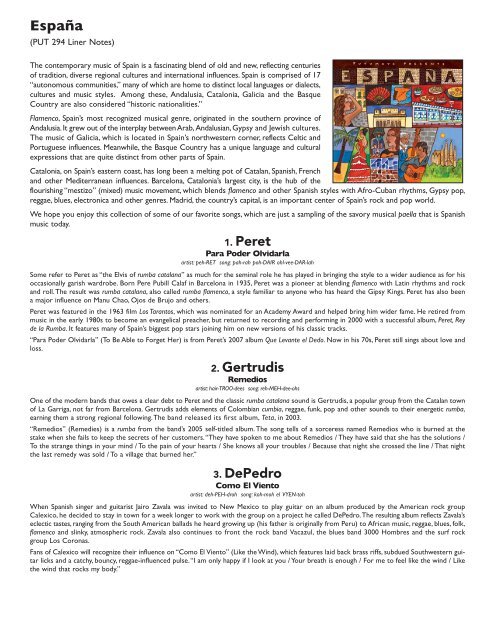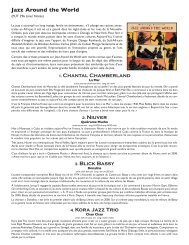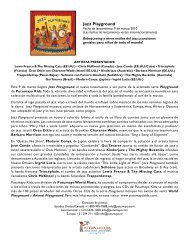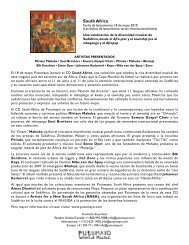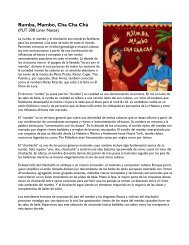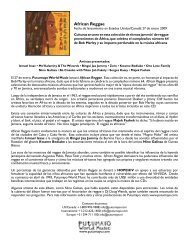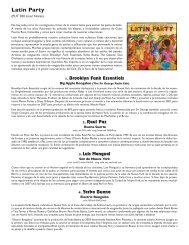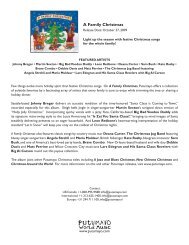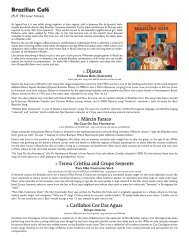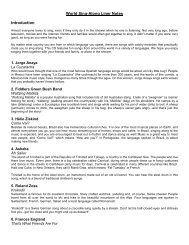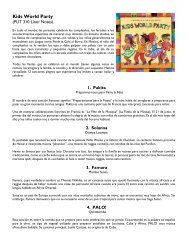Create successful ePaper yourself
Turn your PDF publications into a flip-book with our unique Google optimized e-Paper software.
España<br />
(PUT 294 Liner Notes)<br />
The contemporary music of Spain is a fascinating blend of old and new, reflecting centuries<br />
of tradition, diverse regional cultures and international influences. Spain is comprised of 17<br />
“autonomous communities,” many of which are home to distinct local languages or dialects,<br />
cultures and music styles. Among these, Andalusia, Catalonia, Galicia and the Basque<br />
Country are also considered “historic nationalities.”<br />
Flamenco, Spain’s most recognized musical genre, originated in the southern province of<br />
Andalusia. It grew out of the interplay between Arab, Andalusian, Gypsy and Jewish cultures.<br />
The music of Galicia, which is located in Spain’s northwestern corner, reflects Celtic and<br />
Portuguese influences. Meanwhile, the Basque Country has a unique language and cultural<br />
expressions that are quite distinct from other parts of Spain.<br />
Catalonia, on Spain’s eastern coast, has long been a melting pot of Catalan, Spanish, French<br />
and other Mediterranean influences. Barcelona, Catalonia’s largest city, is the hub of the<br />
flourishing “mestizo” (mixed) music movement, which blends flamenco and other Spanish styles with Afro-Cuban rhythms, Gypsy pop,<br />
reggae, blues, electronica and other genres. Madrid, the country’s capital, is an important center of Spain’s rock and pop world.<br />
We hope you enjoy this collection of some of our favorite songs, which are just a sampling of the savory musical paella that is Spanish<br />
music today.<br />
1. Peret<br />
Para Poder Olvidarla<br />
artist: peh-RET song: pah-rah poh-DAIR ohl-vee-DAR-lah<br />
Some refer to Peret as “the Elvis of rumba catalana” as much for the seminal role he has played in bringing the style to a wider audience as for his<br />
occasionally garish wardrobe. Born Pere Pubill Calaf in Barcelona in 1935, Peret was a pioneer at blending flamenco with Latin rhythms and rock<br />
and roll.The result was rumba catalana, also called rumba flamenco, a style familiar to anyone who has heard the Gipsy Kings. Peret has also been<br />
a major influence on Manu Chao, Ojos de Brujo and others.<br />
Peret was featured in the 1963 film Los Tarantos, which was nominated for an Academy Award and helped bring him wider fame. He retired from<br />
music in the early 1980s to become an evangelical preacher, but returned to recording and performing in 2000 with a successful album, Peret, Rey<br />
de la Rumba. It features many of Spain’s biggest pop stars joining him on new versions of his classic tracks.<br />
“Para Poder Olvidarla” (To Be Able to Forget Her) is from Peret’s 2007 album Que Levante el Dedo. Now in his 70s, Peret still sings about love and<br />
loss.<br />
2. Gertrudis<br />
Remedios<br />
artist: hair-TROO-dees song: reh-MEH-dee-ohs<br />
One of the modern bands that owes a clear debt to Peret and the classic rumba catalana sound is Gertrudis, a popular group from the Catalan town<br />
of La Garriga, not far from Barcelona. Gertrudis adds elements of Colombian cumbia, reggae, funk, pop and other sounds to their energetic rumba,<br />
earning them a strong regional following.The band released its first album, Teta, in 2003.<br />
“Remedios” (Remedies) is a rumba from the band’s 2005 self-titled album. The song tells of a sorceress named Remedios who is burned at the<br />
stake when she fails to keep the secrets of her customers.“They have spoken to me about Remedios / They have said that she has the solutions /<br />
To the strange things in your mind / To the pain of your hearts / She knows all your troubles / Because that night she crossed the line / That night<br />
the last remedy was sold / To a village that burned her.”<br />
3. DePedro<br />
Como El Viento<br />
artist: deh-PEH-droh song: koh-moh el VYEN-toh<br />
When Spanish singer and guitarist Jairo Zavala was invited to New Mexico to play guitar on an album produced by the American rock group<br />
Calexico, he decided to stay in town for a week longer to work with the group on a project he called DePedro.The resulting album reflects Zavala’s<br />
eclectic tastes, ranging from the South American ballads he heard growing up (his father is originally from Peru) to African music, reggae, blues, folk,<br />
flamenco and slinky, atmospheric rock. Zavala also continues to front the rock band Vacazul, the blues band 3000 Hombres and the surf rock<br />
group Los Coronas.<br />
Fans of Calexico will recognize their influence on “Como El Viento” (Like the Wind), which features laid back brass riffs, subdued Southwestern guitar<br />
licks and a catchy, bouncy, reggae-influenced pulse.“I am only happy if I look at you / Your breath is enough / For me to feel like the wind / Like<br />
the wind that rocks my body.”
4. Burguitos<br />
Por Los Besos Que Me Das<br />
artist: boorg-EE-tohs song: por lohs beh-sohs kay may dahs<br />
Fernando Burgos, known as Burguitos, started his music career more than 25 years ago in Valencia, the capital and largest city in the Southeastern<br />
province of the same name. Also a talented actor and painter, Burguitos started his first band, Piedras en el Riñon, in the late 1970s. In the 80s, he<br />
formed the comedic salsa/pop group Combo Potombo, followed by the band Stilo Grafico. In the early 90s, Burgos renamed his band Burguitos<br />
and they often blend rumba, pop and world music flavors with humorous and satirical lyrics to create a fun, upbeat sound.<br />
“Por Los Besos Que Me Das” (For the Kisses that You Give Me), from the 2007 album of the same name, displays Burgos’ singer-songwriter skills.<br />
“For the kisses you give me / They make me lose my mind / It’s hard to know who I am / You hit the dance floor / I follow you with my eyes / I<br />
join your orbit / Let’s go to Pluto / And count the stars one by one.”<br />
5. Calima<br />
Lunita<br />
artist: kah-LEE-mah song: loo-NEE-tah<br />
Calima was founded in 2005 by Juanlu “El Canijo” Leprevost, who is best-known on the Spanish music scene as one of the co-founders of Ojos de<br />
Brujo. Calima’s debut album Azul earned raves from Spanish media and a Latin Grammy nomination for Best Flamenco Album.The band has performed at<br />
many important festivals across Europe and is fast developing a following for its hip, jazzy and soulful rumba flamenco sound.<br />
Calima’s second album, Tierra, was released in 2009 and featured this song,“Lunita” (Little Moon). Its musical vibe is similar in spirit to the Ojos de<br />
Brujo style, although with more jazz fusion influences.The song tells of the pain of unrequited love.“Yesterday I spoke to the moon / I took a walk<br />
with her / She told me of her happiness / And also her suffering / She’s in love with the sun / How it hurts, love.”<br />
6. Gossos featuring Dani Macaco<br />
Corren<br />
artist: goh-sohs featuring dah-nee mah-KAH-koh song: koh-ren<br />
Gossos is one of the most popular Catalonian rock groups, having built a faithful fan base since they got their start in the early 90s. Formed in<br />
Manresa, a small city in the heart of Catalonia, the band began with an acoustic sound and over the years has become increasingly<br />
electrified and harder-edged. They have released nine studio albums so far and their most recent, 2007’s Oxigen, received rave reviews and won<br />
numerous awards.<br />
Part of the album’s success surely comes from the catchy appeal of the love song “Corren” (Run), which features popular Barcelona singer Dani<br />
Macaco on guest vocals. “It’s late, I don’t know what time it is / But it’s been dark for a while / It’s easy to see that you are not here / I want to<br />
run, run down the streets.”<br />
7. El Combolinga<br />
Cumbia Caimanera<br />
artist: el kom-boh-LEEN-gah song: KOOM-bee-ya kye-mah-NEH-rah<br />
Founded nearly thirteen years ago in Madrid, El Combolinga’s guiding philosophy is “mestizaje,” or mixture, and this is reflected in their eclectic range<br />
of influences. Flamenco, reggae, rock, Afro-Cuban music, jazz, ska, African grooves — it all makes an appearance in the El Combolinga sound.The group<br />
has released five albums so far and their many concert appearances include touring the world alongside Bebe, one of Spain’s fastest rising stars.<br />
El Combolinga’s latest album, Mira Que Bien, was released in 2008 and includes this electrified twist on a traditional Colombian cumbia. On<br />
“Cumbia Caimanera” (Caiman Cumbia), the group sings,“From the other side of the river, where there are no streetlights / Fountains are dry and<br />
we don’t put foot to ball / That’s where we the caimans live / Without a job or glamour / We have big mouths and our eyes are looking south /<br />
That’s why we sing looking towards the south.”<br />
8. Uxía<br />
Danza Ritual<br />
artist: oosh-EE-ah song: dahn-sah ree-too-ahl<br />
Uxía is one of Galicia’s most respected and internationally acclaimed singers.The province borders Portugal and its regional language, Gallego, is<br />
closely related to Portuguese. As a result, Uxía has long felt a kinship with Portuguese culture.<br />
Uxía recorded her first solo album in 1986 and was a member of the seminal Galician folk revival band Na Lua until she left in 1991 to focus on<br />
her own work. In 1997, she recorded the album La Sal de la Vida alongside Spanish singer María Salgado and Sudanese singer Rasha. Over the years,<br />
Uxía has explored ways in which to connect her Galician roots with the traditions of other cultures both near and far.<br />
“You are still the spider / That spins my fate,” Uxía sings on “Danza Ritual” (Ritual Dance),“And together we shall dance / A ritual, creole and impure<br />
dance.”<br />
9. Xabier Lete<br />
San Martin, Azken Larrosa<br />
artist: hah-byer leh-teh song: san mar-TEEN ahz-kehn lah-ROH-sah<br />
The Basque Country is an “historic nationality” that spans the Pyrenees Mountains between Spain and France. Born in 1944 in the Basque village of<br />
Oyarzun (Oiartzun), Xabier Lete is one of his region’s most beloved singer-songwriters. Proud of his Basque heritage, Lete’s writing often addresses<br />
the region’s struggle to maintain its unique culture.
Lete began his writing career as a journalist and then joined the band Ez Dok Aimaru, composing and singing in the Basque language (which locals call<br />
Euskera). He is also known for his poetry and plays.<br />
“San Martin, Azken Larrosa” (Saint Martin, The Last Rose) appeared on Lete’s 1992 album Hurbil Iragana and refers to the day of Saint Martin on<br />
November 11, which roughly heralds the start of winter. “Come, darling, and let’s cut the last rose together / As Saint Martin Day will come soon /<br />
And so, patiently / We will put out the last light together.”<br />
10. Gecko Turner<br />
Te Estás Equivocando<br />
artist: geh-koh turner song: tay es-TAHS eh-kee-voh-KAHN-doh<br />
Born and raised in Badajoz, Spain, a city within the Autonomous Community of Extremadura near the Portuguese border, Gecko Turner listened to<br />
an eclectic range of music growing up. A fan of Bob Dylan,The Beatles and The Rolling Stones, he also enjoyed reggae, funk, blues, jazz and many other<br />
styles which have influenced his songs. After living for a while in London,Turner returned to Spain and began touring with the band Perroflauta.<br />
Turner’s first solo album, Guapapasea!, was released in 2006.“Te Estás Equivocando” (You Are Getting It Wrong), from that album, is a catchy, reggae-flavored<br />
track with a bit of a Manu Chao vibe.“Hey, girl / Whatever you want is gonna happen / Ain’t it the same, love and pleasure? / You are<br />
getting it wrong, mama / You gotta learn from your mistakes.”<br />
11. Biella Nuei<br />
Pasapeanas<br />
artist: byeh-lah noo-wey song: pah-sah-pay-ah-nahs<br />
The musical collective Biella Nuei has been studying and performing traditional music from the Aragón region since the early 80s. Situated in the<br />
north of Spain at the base of the Pyrenees, Aragon’s music tradition features styles such as fandango, polka and others. Local instruments include<br />
salterio (a string drum), chiflo (a three-holed flute), gaita de boto (a type of bagpipe), as well as numerous percussion and stringed instruments.<br />
The members of Biella Nuei are not purists, however, and they often incorporate instruments and music elements from other regions of Spain and<br />
the Middle East. In addition to recording four albums, group members direct instrument-making workshops, publish books on Aragonese traditions<br />
and teach music classes at the Saragossa Folklore School.<br />
“Pasapeanas” is from the group’s most recent album, Sol d’ibierno, which was released in 2006.This excerpt reflects the Celtic flavors that have<br />
seeped into Aragonese folk music over the centuries, along with influences from the traditional music of Italy, France and North Africa.<br />
Torrijas de Natillas (Spanish Bread Pudding)<br />
Ingredients:<br />
1 loaf of stale bread<br />
8 egg yolks<br />
4 1/2 cups (1 liter) milk<br />
1/2 cup and 3 tbsp (150 grams) sugar<br />
2 cinnamon sticks<br />
flour<br />
olive oil<br />
Garnish:<br />
4 tbsp powdered sugar<br />
powdered cinnamon<br />
4 tbsp raspberry sauce<br />
12 raspberries<br />
12 currants<br />
Preparation<br />
Set aside 1/2 cup of the milk and heat the rest in a saucepan with the sugar and the cinnamon sticks. Beat the egg yolks with the reserved milk. Add<br />
some of the hot milk, mix well, and pour the mixture back in the saucepan.<br />
Cook until thick, stirring constantly.<br />
Cut the bread into inch-thick (2 to 3 cm) slices and place in a deep dish. Cover the slices with the custard and wait until they are well soaked. Coat the slices<br />
in flour and fry until brown on both sides in a frying pan with abundant oil.<br />
Drain on paper towels and place in a serving dish.<br />
Mix the powdered sugar with the powdered cinnamon and sprinkle on the toast. Garnish with raspberry sauce, raspberries and currants. If desired, aromatize<br />
some with a hint of anise. Makes 4 servings.<br />
Recipe courtesy of Chef Eva Arguiñano, head of bakery and pastries at Karlos Arguiñano’s restaurant Zarautz in the Basque Country, Spain. www.hogarutil.com


